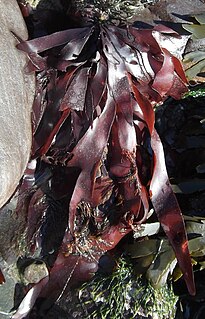
Palmaria palmata, also called dulse, dillisk or dilsk, red dulse, sea lettuce flakes, or creathnach, is a red alga (Rhodophyta) previously referred to as Rhodymenia palmata. It grows on the northern coasts of the Atlantic and Pacific Oceans. It is a well-known snack food. In Iceland, where it is known as söl[ˈsœːl̥], it has been an important source of dietary fiber throughout the centuries.

Fucus serratus is a seaweed of the north Atlantic Ocean, known as toothed wrack or serrated wrack.

Atractophora hypnoides is a rare red alga (Rhodophyta) found in the British Isles, France and some Atlantic Islands and is the only species of the genus found in the British Isles. It is attached to the rock or other algae by a small basal disc and is much branched with downgrowing filaments which enclose the main branch or axis forming a cortex. Short filaments of limited growth radiate in whorls from the axis and frequently convert into hairs. The spreading filaments grow irregularly in a diffuse manner. Microscope examination is required for identification.
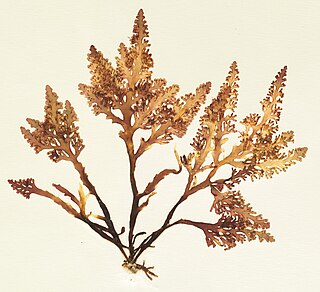
Osmundea pinnatifida is a species of red alga known by the common name pepper dulse.
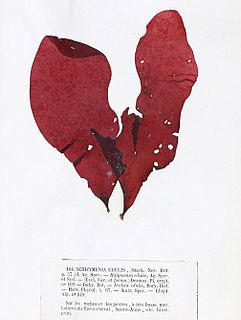
Dilsea carnosa, commonly known as the poor man's weather glass or the sea belt, is a species of red algae in the Dumontiaceae family of the order Gigartinales.

Polysiphonia lanosa is a common species of the red algae (Rhodophyta) often to be found growing on Ascophyllum nodosum.

Choreocolax polysiphoniae is a minute marine parasitic alga in the division Rhodophyta.
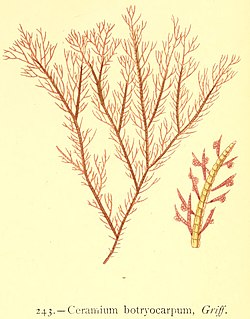
Ceramium botryocarpum is a small red marine alga in the Division Rhodophyta.

Halidrys siliquosa is a large marine brown algae.

Plocamium cartilagineum is a medium-sized red marine alga.
Hypoglossum hypoglossoides, known as under tongue weed, is a small red marine alga in the family Delesseriaceae.

Phycodrys rubens is a red marine alga of up to 30 cm long.

Phyllophora crispa is a medium-sized marine red alga.
Phyllophora sicula, the hand leaf bearer, is a small red marine alga.
Phyllophora traillii is a small marine red alga.

Prasiola crispa is a small terrestrial green alga.
Prasiola furfuracea is a small green alga that grows terrestrially.
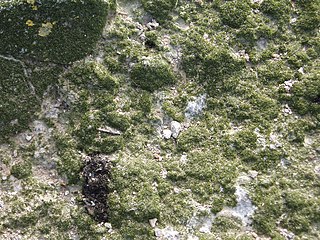
Prasiola stipitata is a small green alga.

Gymnogongrus griffithsiae is a small uncommon seaweed.
Gastroclonium reflexum is a small red marine seaweed.














